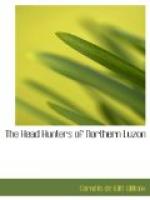There is nothing picturesque about the lower reaches of the Rio Grande, though its upper course, through hilly country, is different in this respect. The remains of one or two old towns, cut in two by the shift of the river-bed, excited our curiosity. So did, from to time, the barangayans, or native river-boats, huge, clumsy, ill-built, and generally with but four or five inches of free-board amidships on full load. These craft look as though they ought to sink by mere capillary attraction. However, people are born, live, and die aboard of them, so they must be safe enough. In the afternoon the river widened and its right bank, anyway, grew bolder and occasionally more permanent-looking, and finally, about an hour before sunset, we perceived the low white godowns of Aparri. We landed not at a wharf, but at the outer edge of the huddle of craft crowding the water front, and put up at the Fonda de Aparri, having done eighty-odd miles in a little over ten hours.
All the tobacco of the Valley reaches the world through Aparri; it is consequently a port of considerable importance. But it has no safe anchorage and is frightfully exposed to typhoons, all of which, if they do not pass over the place directly, somehow or other appear to step aside to give this region a blow. There is a never-ending conflict in the adjacent waters between the currents of the China Sea and those of the Pacific, making navigation hazardous, and for small boats perilous. On the day of our arrival, calm and fair as it was, a tremendous surf was beating on the bar, the spray and foam mounting in a regular wall many feet high, and driven up, not by the gradual attack of an advancing wave, but by the tireless energy of angry waters ceaselessly beating upon the same spot.
Of Aparri itself little can be said here: but, small as it is, it has nevertheless the bustle of all seaports in activity. Many of its streets are paved with cobble-stones, and some of its buildings are, if not handsome, at least substantial. But it is cursed with flies: in our inn, otherwise comfortable enough, the kitchen and the temple of Venus Cloacina were side by side. The flies were all the more annoying that we had seen none in the mountains, nor indeed do I recollect ever having seen them in any number elsewhere in the Archipelago than at Aparri and in the never-to-be-forgotten plain of Tabuk. However, we survived the flies, and late in the afternoon of the third day went on board a Spanish steamer bound for Manila. We used our cabin to stow our kit, but lived and slept on the deck of the poop, the main deck between which and the forecastle was crowded with natives. Poor things! Each family appeared to have an area assigned to it, on which were piled indiscriminately all its earthly possessions in the shape of clothes, bags, pots and pans generally; the heap once formed, its owners sat and slept on it, with the inevitable family rooster at its highest point lording it over all.




